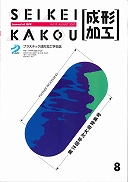Volume 19, Issue 8
Displaying 1-35 of 35 articles from this issue
- |<
- <
- 1
- >
- >|
Index
-
2007 Volume 19 Issue 8 Pages Index8_1-Index8_2
Published: August 20, 2007
Released on J-STAGE: February 25, 2021
Download PDF (574K)
Preface
-
2007 Volume 19 Issue 8 Pages 453
Published: August 20, 2007
Released on J-STAGE: February 25, 2021
Download PDF (609K)
Reports on 18th Annuual Meeting of JSPP
-
2007 Volume 19 Issue 8 Pages 454
Published: August 20, 2007
Released on J-STAGE: February 25, 2021
Download PDF (751K)
-
2007 Volume 19 Issue 8 Pages 455
Published: August 20, 2007
Released on J-STAGE: February 25, 2021
Download PDF (853K) -
2007 Volume 19 Issue 8 Pages 455-456
Published: August 20, 2007
Released on J-STAGE: February 25, 2021
Download PDF (863K) -
2007 Volume 19 Issue 8 Pages 456
Published: August 20, 2007
Released on J-STAGE: February 25, 2021
Download PDF (852K) -
2007 Volume 19 Issue 8 Pages 456-457
Published: August 20, 2007
Released on J-STAGE: February 25, 2021
Download PDF (859K)
-
2007 Volume 19 Issue 8 Pages 457
Published: August 20, 2007
Released on J-STAGE: February 25, 2021
Download PDF (853K) -
2007 Volume 19 Issue 8 Pages 458
Published: August 20, 2007
Released on J-STAGE: February 25, 2021
Download PDF (853K) -
2007 Volume 19 Issue 8 Pages 458
Published: August 20, 2007
Released on J-STAGE: February 25, 2021
Download PDF (853K) -
2007 Volume 19 Issue 8 Pages 459
Published: August 20, 2007
Released on J-STAGE: February 25, 2021
Download PDF (856K) -
2007 Volume 19 Issue 8 Pages 459
Published: August 20, 2007
Released on J-STAGE: February 25, 2021
Download PDF (856K) -
2007 Volume 19 Issue 8 Pages 460
Published: August 20, 2007
Released on J-STAGE: February 25, 2021
Download PDF (851K) -
2007 Volume 19 Issue 8 Pages 460
Published: August 20, 2007
Released on J-STAGE: February 25, 2021
Download PDF (851K)
-
2007 Volume 19 Issue 8 Pages 460
Published: August 20, 2007
Released on J-STAGE: February 25, 2021
Download PDF (858K)
-
2007 Volume 19 Issue 8 Pages 461
Published: August 20, 2007
Released on J-STAGE: February 25, 2021
Download PDF (854K) -
2007 Volume 19 Issue 8 Pages 461-462
Published: August 20, 2007
Released on J-STAGE: February 25, 2021
Download PDF (858K) -
2007 Volume 19 Issue 8 Pages 463
Published: August 20, 2007
Released on J-STAGE: February 25, 2021
Download PDF (854K) -
2007 Volume 19 Issue 8 Pages 463
Published: August 20, 2007
Released on J-STAGE: February 25, 2021
Download PDF (854K) -
2007 Volume 19 Issue 8 Pages 464
Published: August 20, 2007
Released on J-STAGE: February 25, 2021
Download PDF (851K)
-
2007 Volume 19 Issue 8 Pages 465
Published: August 20, 2007
Released on J-STAGE: February 25, 2021
Download PDF (553K) -
2007 Volume 19 Issue 8 Pages 466
Published: August 20, 2007
Released on J-STAGE: February 25, 2021
Download PDF (508K) -
2007 Volume 19 Issue 8 Pages 467
Published: August 20, 2007
Released on J-STAGE: February 25, 2021
Download PDF (1355K)
Technical Notes-Keynote Lectures in 18th Annuual Meeting of JSPP
-
2007 Volume 19 Issue 8 Pages 468-472
Published: August 20, 2007
Released on J-STAGE: February 25, 2021
Download PDF (13861K)
Reports on 17th "Aoki-Katashi" Award
-
2007 Volume 19 Issue 8 Pages 473-475
Published: August 20, 2007
Released on J-STAGE: February 25, 2021
Download PDF (2098K) -
2007 Volume 19 Issue 8 Pages 476-479
Published: August 20, 2007
Released on J-STAGE: February 25, 2021
Download PDF (3277K)
Special Lecture-Fabrication Techniques Improving Product Function-Bonding, Welding, Multilayer and Other Processes-
-
2007 Volume 19 Issue 8 Pages 480-484
Published: August 20, 2007
Released on J-STAGE: February 25, 2021
Download PDF (7209K)
Report from Universities and Institusions in Japan : 154
-
2007 Volume 19 Issue 8 Pages 485-490
Published: August 20, 2007
Released on J-STAGE: February 25, 2021
Download PDF (6065K)
Reports of International Meeting
-
2007 Volume 19 Issue 8 Pages 491-493
Published: August 20, 2007
Released on J-STAGE: February 25, 2021
Download PDF (3536K) -
2007 Volume 19 Issue 8 Pages 494-497
Published: August 20, 2007
Released on J-STAGE: February 25, 2021
Download PDF (4316K)
Original Papers
-
2007 Volume 19 Issue 8 Pages 498-504
Published: August 20, 2007
Released on J-STAGE: January 09, 2009
Download PDF (2645K) -
2007 Volume 19 Issue 8 Pages 505-511
Published: August 20, 2007
Released on J-STAGE: January 09, 2009
Download PDF (5094K)
Fountain Flow
-
2007 Volume 19 Issue 8 Pages 493
Published: August 20, 2007
Released on J-STAGE: February 25, 2021
Download PDF (1437K) -
2007 Volume 19 Issue 8 Pages 497
Published: August 20, 2007
Released on J-STAGE: February 25, 2021
Download PDF (1252K)
-
2007 Volume 19 Issue 8 Pages 490
Published: August 20, 2007
Released on J-STAGE: December 27, 2023
Download PDF (946K)
- |<
- <
- 1
- >
- >|
